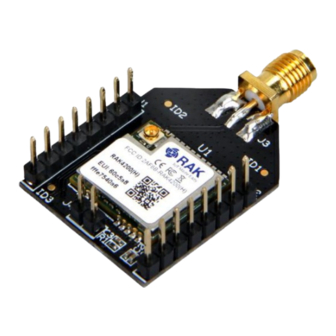Summary of Contents for RAKwireless RAK4200
- Page 1 Quick Start Guide LPWAN Evaluation Board RAK4200 Breakout Board Version 1.0 | April 2020 www.RAKwireless.com Visit our website for the latest copy of this manual.
-
Page 2: Table Of Contents
1.2 Product Background........................3 Prerequisites............................4 2.1 Hardware tools..........................4 2.2 Software tools..........................4 Configuration............................5 3.1 Interfacing with the RAK4200 Evaluation Board................ 5 3.2 Connecting to The Things Network (TTN).................. 8 3.2.1 Adding an Application......................8 3.2.2 Registering a device......................10 4 Revision History...........................19... -
Page 3: Product Overview
RAK4200 Breakout Module is specifically designed to allow easy excess to the pins on the module in order to simplify development and testing. The breakout board utilized is of an Xbee form factor and its main purpose is to allow the RAK4200 stamp module form factor pinout to be transferred to 2.54mm headers. -
Page 4: Prerequisites
Some of those are included in the package, others you need to provide yourself. Hardware tools RAK4200 LPWAN Evaluation Board (provided) – including LoRa® antenna, Dupont lines (13x) USB to UART converter – CH340 for example (not provided) ... -
Page 5: Configuration
LoRa® Antenna. Not doing so might damage the board. Connect your USB to UART converter to the pin header on the RAK4200 via a set of 4 dupont lines. Use Figure 2 for reference on wiring the device properly. - Page 6 RAK4200 Breakout Module Figure 3 | COM port settings...
- Page 7 RAK4200 Breakout Module Open the RAK Serial Port Tool. Select the COM Port number (the one you noted in the previous step) and set the Baud Rate to 115200. Click “OPEN” and you should be connected to the board and be able to send commands.
-
Page 8: Connecting To The Things Network (Ttn)
RAK4200 Breakout Module Connecting to The Things Network (TTN) The Things Network is about enabling low power Devices to use long range Gateways to connect to an open-source, decentralized Network to exchange data with Applications. Learn more about the Things Network here. - Page 9 RAK4200 Breakout Module Figure 7 | Application parameters Here are the things that you should take note in adding an application: Application ID - this will be the unique id of your application in the Network. Please note that characters should be in lower case, no spaces are allowed.
-
Page 10: Registering A Device
Registering a device 3.2.2 Now we need to add our actual device (RAK4200). Refer to Figure 8 again and press the “register device” button that is marked with the red rectangle. Now you need to set some device parameters (Figure 9) - Page 11 Here are the things that you should take note in registering your device: Device ID - this is the unique identifier for your RAK4200 EVB within the particular application. You need to enter this manually. Device EUI - this is the unique identifier for your device in the network.
- Page 12 RAK4200 Breakout Module Figure 10 | Device Overview page Take note of the Activation Method which is set to OTAA by default (Figure 10). This is one of two options, ABP being the second one. We will provide instructions on both methods in the following sections, starting with OTAA.
- Page 13 RAK4200 Breakout Module Figure 11 | OTAA parameters set As these are randomly generated by TTN we need to update our RAK4200 with their values in order to be able to register it with the network. Note For the sake of this tutorial we will use an example that works withing the EU868 band in LoRa®...
- Page 14 RAK4200 Breakout Module at+set_config=lora:class:0 Set the device region to EU868: at+set_config=lora:region:EU868 Executing the set of commands above in order should result in a command output in the RAK Serial tool much like the one in Figure 12: Figure 12 | Device Setup - 1...
- Page 15 RAK4200 Breakout Module Next, we need to set the authentication parameters. You can copy those from the Device Overview page (Figure 11). Replace the XXXX in the commands below with your particular set of symbols. Set the Device EUI: ...
- Page 16 RAK4200 Breakout Module Executing the set of commands above in order should result in a command output in the RAK Serial tool much like the one in Figure 13 (the values there are just an example): Figure 13 | Device Setup - 2 ...
- Page 17 RAK4200 Breakout Module Join the network at+join Figure 14 | Device successful join and test data If you look at Figure 14 you will see what you should expect as output after a successful joining of the network. The device will report the join mode (OTAA in this case) and the parameters (Device EUI, Application EUI, and App Key) it is using for the join procedure.
- Page 18 RAK4200 Breakout Module Figure 15 | Device real time status update after authentication As your device has now been authenticated it can now send uplink frames. Send an Uplink LoRa® frame at+send=lora:2:0123456789 Additionally, you should also see this in the TTN console provided you have access to a Gateway.
-
Page 19: Revision History
Vladislav About RAKwireless: RAKwireless is a pioneer in providing innovative and diverse Cellular and LoRaWAN connectivity solutions for both Edge and Gateway IoT devices. We believe that through easy to use and modular designs we can accelerate the time to market for various IoT Applications in order to...





Need help?
Do you have a question about the RAK4200 and is the answer not in the manual?
Questions and answers